P
parallel sides
Sides on a shape that are always the same distance apart and
never meet.
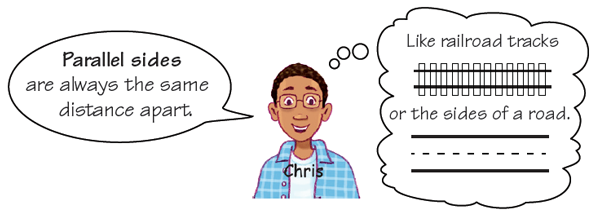
pages 278, 289, 290–292
parallelogram
A quadrilateral with two pairs of parallel sides.

pages 194, 278, 281, 287–289, 292
parentheses ( )
Parentheses say that the calculations inside the parentheses should be done first. Here the parentheses say to subtract first:
(6 − 2) × 3 = ?
4 × 3 = 12
pages 344–346, 446–448
partial product
A product of one digit of each of the numbers of a multidigit multiplication problem.
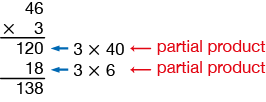
pages 168–169, 180, 184–185, 307, 406, 408, 503
partial quotient (division method)
A method of division using estimation.

pages 306, 307, 310, 312–313, 315–319, 417–418
partitive division
Division as equal sharing. The total number of objects and the number of groups are known. The number of objects in each group is the unknown. For example, Frank has 144 marbles that he divides equally into 6 groups. How many marbles are in each group?
pentagon
A five-sided polygon.

page 194
perimeter
The distance around a two-dimensional shape.
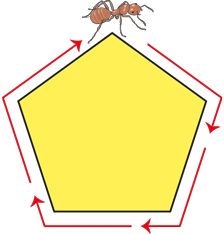
pages 181, 189, 552
period
A group of three places in a large number, starting on the right, often separated by commas, is called a period.
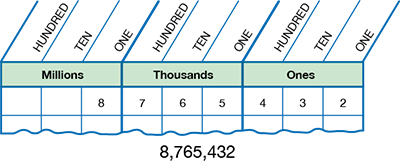
pages 123–124
pi,
The ratio of a circle's circumference to its diameter. About 3 diameters wrap around the circumference of a circle.  = 3.14159265358979323846 . . . (the digits go on forever without repeating).
= 3.14159265358979323846 . . . (the digits go on forever without repeating).
page 556
place value
The value of a digit in a number depends upon where it is placed.
For example, the 2 in 329 stands for 2 tens but the 2 in 7293 is 2 hundreds.
pages 120–128, 157, 373, 375, 390–391
place value chart
A chart that shows the ones, thousands, and millions places for students to write numbers.

pages 157, 373, 390–391
plotting
To place a point on a coordinate plane by using x and y coordinates.
pages 276–281, 433–436
point
An exact position in the plane or in space.
pages 74–75, 76–79, 80–81, 82–85, 87–88, 102–103, 105–108, 117, 126–128, 129–135, 210–215, 243–247, 276–281, 338, 370, 388–389, 396–398, 433–436, 458–459, 460
polygon
A two-dimensional connected figure made of line segments in which each endpoint of every side meets with an endpoint of exactly one other side.

pages 276–281, 282–289
population
A collection of persons or things whose properties will be analyzed in a survey or experiment.
pages 39, 120–128, 134–135, 136, 565, 577–578
positive number
A number greater than zero; a number to the right of zero on a horizontal number line.
pages 243–245, 251, 272
powers
The number of times a number is multiplied by itself. For example, 21 = 2, 23 = 2 × 2 × 2 = 8, etc.
pages 153, 439
prime factorization
Finding which prime numbers can be multiplied together to produce a number (e.g., the prime factorization of 12 is 2 × 2 × 3).
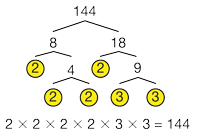
pages 443–445
prime number
A number that has exactly two factors, itself and 1. For example, 7 has exactly two distinct factors, 1 and 7. (See also composite number.)
pages 424, 427, 429–431, 443–445, 449
product
The answer to a multiplication problem. In the problem 3 × 4 = 12, 12 is the product.
pages 54, 136–143, 168–169, 178–185, 200–201, 307, 400–410, 442–445, 493–495, 498–502, 503, 506–507, 516
proper fraction
A fraction in which the numerator is less than the denominator. Proper fractions have a value less than one.
page 70
property
An attribute or characteristic of a shape that helps identify it.
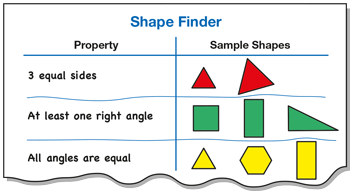
pages 137, 280, 285
proportion
A statement indicating that two ratios are equal.

pages 518–525, 526–536, 543–550, 560–581










